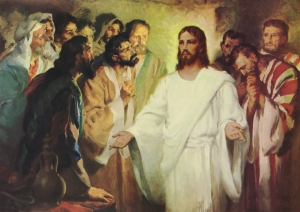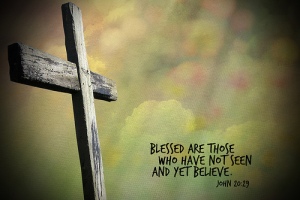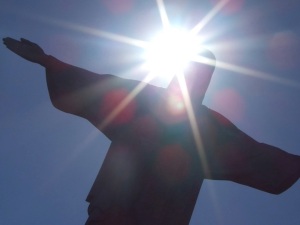“Living Alive”
John 11:1-45 and Romans 6:1b-11
June 25, 2017, First Presbyterian Church of Holt
Listen here
 Mary and Martha. These two famous sisters are in several stories throughout the Bible. Our first introduction to Mary is when she comes to Jesus gathered together with his disciples, breaks a jar of expensive perfume to anoint his feet. At this time she is simply introduced as “a woman who was a sinner”. The disciples criticize her for her wastefulness, but Jesus comes to her defense praising Mary for the love that she showed him, and saying, “Your faith has saved you; go in peace.”
Mary and Martha. These two famous sisters are in several stories throughout the Bible. Our first introduction to Mary is when she comes to Jesus gathered together with his disciples, breaks a jar of expensive perfume to anoint his feet. At this time she is simply introduced as “a woman who was a sinner”. The disciples criticize her for her wastefulness, but Jesus comes to her defense praising Mary for the love that she showed him, and saying, “Your faith has saved you; go in peace.”
 Then there is the story of Mary and Martha welcoming Jesus into their home. Martha buzzes about the kitchen, going about the work of welcoming Jesus. To Martha’s chagrin, Mary sits with Jesus, simply being with him. When Martha comes to Jesus to complain that Mary’s not doing her share, Jesus says, “Mary has chosen the better part.”
Then there is the story of Mary and Martha welcoming Jesus into their home. Martha buzzes about the kitchen, going about the work of welcoming Jesus. To Martha’s chagrin, Mary sits with Jesus, simply being with him. When Martha comes to Jesus to complain that Mary’s not doing her share, Jesus says, “Mary has chosen the better part.”
 Today we have another account of these sisters. Their brother, Lazarus is ill, and so they send word to Jesus to let him know it was a matter of life or death. Jesus dismisses this news saying, “This illness does not lead to death; rather it is for God’s glory, so that the Son of God may be glorified through it.” We are told in our passage that Jesus loved Martha, Mary, and Lazarus, but still, Jesus stays two days longer where he was.
Today we have another account of these sisters. Their brother, Lazarus is ill, and so they send word to Jesus to let him know it was a matter of life or death. Jesus dismisses this news saying, “This illness does not lead to death; rather it is for God’s glory, so that the Son of God may be glorified through it.” We are told in our passage that Jesus loved Martha, Mary, and Lazarus, but still, Jesus stays two days longer where he was.
 What sort of love is this showing? Saying that God will be glorified through their brother’s illness? God’s goodness and grace is present in all circumstances, but Jesus’ summation of God’s glory in this situation rings of all of those aphorisms that we tell to grieving people when we’re not sure what to say. “It’s God’s will,” “everything happens for a reason,” and “no use dwelling on it,” can ring hollow to someone in the depth of grief and sadness. The emotions of a grieving person are not to be assumed and can only be truly understood by the person experiencing the grief. I think my seminary professors would say that Jesus is offering terrible pastoral care.
What sort of love is this showing? Saying that God will be glorified through their brother’s illness? God’s goodness and grace is present in all circumstances, but Jesus’ summation of God’s glory in this situation rings of all of those aphorisms that we tell to grieving people when we’re not sure what to say. “It’s God’s will,” “everything happens for a reason,” and “no use dwelling on it,” can ring hollow to someone in the depth of grief and sadness. The emotions of a grieving person are not to be assumed and can only be truly understood by the person experiencing the grief. I think my seminary professors would say that Jesus is offering terrible pastoral care.
Mary and Martha know that things are not well with their brother and send a message expecting a reply, but Jesus stays away. And then, it’s too late. Lazarus is dead.
 Jesus does not show up to support Mary and Martha until Lazarus has been dead for four days. Four days. Throughout scripture, God acts on the third day. The third day is the day of redemption, heroic recoveries, second chances. But even that day is past. Hebrew beliefs of death say that the spirit hovers near the body after someone has died for three days. On the fourth day, when the spirit sees the face of the deceased turn color, the spirit leaves, never to return. At that point, this existence ended and life was no more. Jesus shows up on the fourth day, the day beyond hope, beyond existence.
Jesus does not show up to support Mary and Martha until Lazarus has been dead for four days. Four days. Throughout scripture, God acts on the third day. The third day is the day of redemption, heroic recoveries, second chances. But even that day is past. Hebrew beliefs of death say that the spirit hovers near the body after someone has died for three days. On the fourth day, when the spirit sees the face of the deceased turn color, the spirit leaves, never to return. At that point, this existence ended and life was no more. Jesus shows up on the fourth day, the day beyond hope, beyond existence.
It was a matter of life or death.
 If you turn on the news there are a terrifying number of situations where innocent lives are killed because of those complex sins of fear, bias, and hatred, all stemming out of a deep well of pain.
If you turn on the news there are a terrifying number of situations where innocent lives are killed because of those complex sins of fear, bias, and hatred, all stemming out of a deep well of pain.
 I watched a very important and troubling video these other days about parents and grandparents explaining to their children how they should respond if stopped by a police officer. I’d like us to watch it together, fully acknowledging that this will likely be uncomfortable for many, but also, that that discomfort can stem from the privilege given by the color of our skin and that for many of us in this room, these are not conversations we’ve ever had to have with children. For others among us, these conversations are likely far too real, perhaps even with your own experience of how who you are has warranted undue attention from law enforcement.
I watched a very important and troubling video these other days about parents and grandparents explaining to their children how they should respond if stopped by a police officer. I’d like us to watch it together, fully acknowledging that this will likely be uncomfortable for many, but also, that that discomfort can stem from the privilege given by the color of our skin and that for many of us in this room, these are not conversations we’ve ever had to have with children. For others among us, these conversations are likely far too real, perhaps even with your own experience of how who you are has warranted undue attention from law enforcement.
https://www.facebook.com/thismatters/videos/714035155442346/
In the video, each adult is adamant that there are both good and bad police officers, even when a high school girl tries to dismiss them as all bad, a mother says, no, there are good ones too.
My heart ached at seeing an 8-year-old recite a well-rehearsed speech, saying her name and that she is unarmed and has nothing that will hurt them. Her father sits next to her and tells were about a time he was stopped in the mall and tased, not because of anything he’d done, but because he was mistaken for someone else. She becomes visibly upset and goes to get a hug from her dad who then is also crying.
There’s a grandmother talking with her two grandsons, pointing out that the lighter complexion child will likely not have to deal with this. Another mother says to her daughter with her voice being to crack, “do everything that you can to get back to me.”
Where is Jesus in all of this?
Martha and Mary were angry.
Jesus shows up and by all signs of logical reason it is too late.
 Martha leaves her home full of mourners and goes out to meet Jesus. She is beside herself, crying out to Jesus, “Lord, if you had been here, my brother would not have died!”
Martha leaves her home full of mourners and goes out to meet Jesus. She is beside herself, crying out to Jesus, “Lord, if you had been here, my brother would not have died!”
Later Martha goes to get Mary and Mary echoes the same refrain, kneeling at Jesus’ feet she says, “Lord if you had been here, my brother would not have died.”
Mary is weeping, the other Jews with Lazarus’ sisters are weeping, and then we are told that Jesus himself is weeping. Lazarus’ sisters are angry, upset, deeply grieving, but still, they do not lose hope. Martha says, “Even now I know that God will give you whatever you ask of him.” She affirms Jesus as the Messiah with confidence in his ability to work out God’s will even in the shadow of their brother’s death. Even on this fourth day. Even beyond any logical reason for hope.
 In their grief, Mary and Martha bring Jesus to the tomb, a cave with a stone in front of it. Jesus says, “take away the stone.” Martha is hesitant, saying, “Lord, already there is a stench because he has been dead four days.” Martha asked Jesus to come, practically demanded a miracle and then when he was on the cusp of something great, Martha is afraid of the smell.
In their grief, Mary and Martha bring Jesus to the tomb, a cave with a stone in front of it. Jesus says, “take away the stone.” Martha is hesitant, saying, “Lord, already there is a stench because he has been dead four days.” Martha asked Jesus to come, practically demanded a miracle and then when he was on the cusp of something great, Martha is afraid of the smell.
“Come out,” Jesus says, and Lazarus emerges. In the hopelessness of the tomb, on this hopeless fourth day, Jesus calls out, and life is restored. Hope is restored.
This is such a strange story.
With all of the believers in the history of time, why is Lazarus selected out to be the one revived from death? His story is not a very long one. He is acknowledged as a man of poverty, a man in need of God’s grace, but aside from that, what is his legacy? Why does he get to come back? Why do Mary and Martha get to continue to have their brother in their lives? We are told explicitly that Mary is a sinner. Martha’s voice throughout her stories is loudest when she’s complaining. What have they done to deserve this?
 What about all those other brothers of weeping sisters? What have they done to deserve this? When is Jesus going to intervene for them?
What about all those other brothers of weeping sisters? What have they done to deserve this? When is Jesus going to intervene for them?
It is in asking these questions we become confronted with the uncomfortable reality that we are Christ’s hands and feet in this world. We are tasked with creating justice, restoring what is right. Sometimes resurrection doesn’t look like a man stepping backward out of a tomb. Sometimes it looks like a community surrounding a family in the face of loss. Sometimes it looks like lobbying and rallying. Often, it looks like listening, watching, and not turning away from the pain and death of those who do not look like we do, knowing full well that they, too, are created in the image of God and by knowing them, we are better able to know God.
 In the strange story of Lazarus, Jesus uncovers hope beyond hope, and new life after death. We affirm in the Apostles Creed that we believe in the resurrection of the body. That after our own death we, like Lazarus will be called out of the doom and gloom of the grave and called to “come out,” into life everlasting.
In the strange story of Lazarus, Jesus uncovers hope beyond hope, and new life after death. We affirm in the Apostles Creed that we believe in the resurrection of the body. That after our own death we, like Lazarus will be called out of the doom and gloom of the grave and called to “come out,” into life everlasting.
This call is not one only to be heard after we are gone from this world. When we accept Jesus Christ as our Lord and Savior we are also being called to “come out,” of the smell of our lives of sinfulness. We are called to live a new life in the world surrounding us, in the bodies we are currently inhabiting, in the lives we are currently living. We are people of second chances. We know that death doesn’t have the final word. We are people of the resurrection. We are called out of the stench of sin into new life. We are called to live like we have already died. When we accept Christ into our lives we are called to die to sin, so that Christ may be alive in us.
And with the Holy Spirit’s breath circulating through us, we are called to speak out for justice, for hope, and for new life devoid of the hatred and pain that have changed us all so completely.
Lazarus was dead. But then, he wasn’t. This is the great hope we have in Jesus Christ: There is life beyond the sin that contains us. There is life beyond this world that constrains us.
God is not through with our world yet. Thanks be to God. Amen.








































































